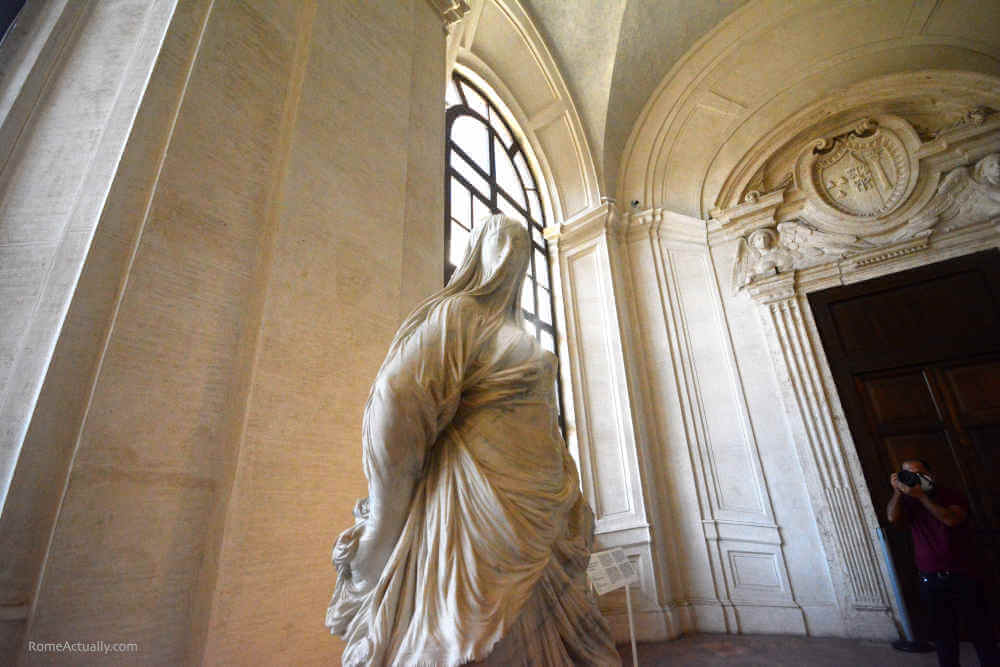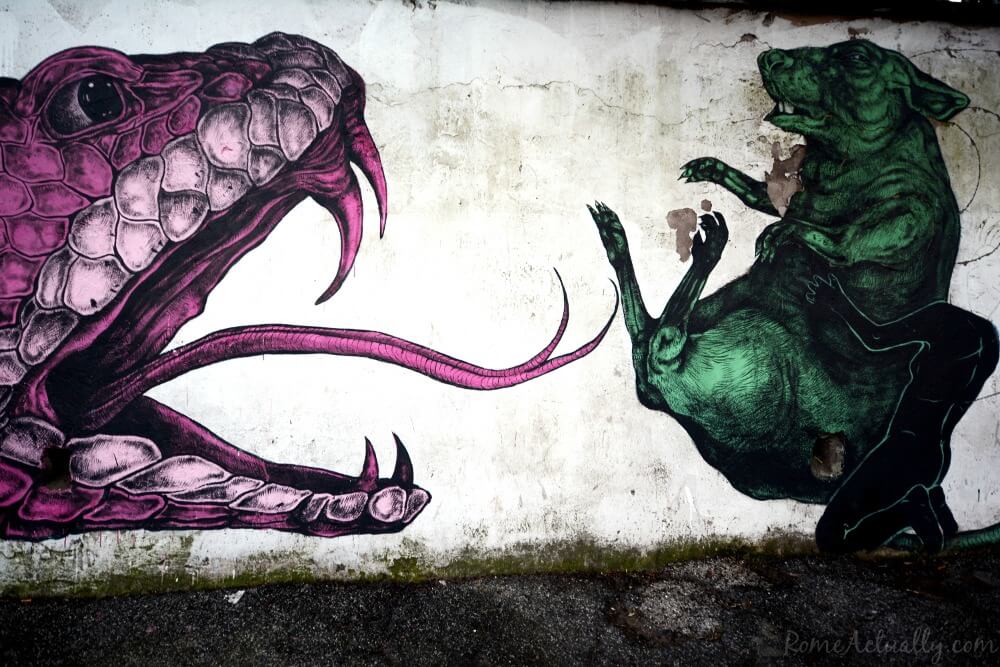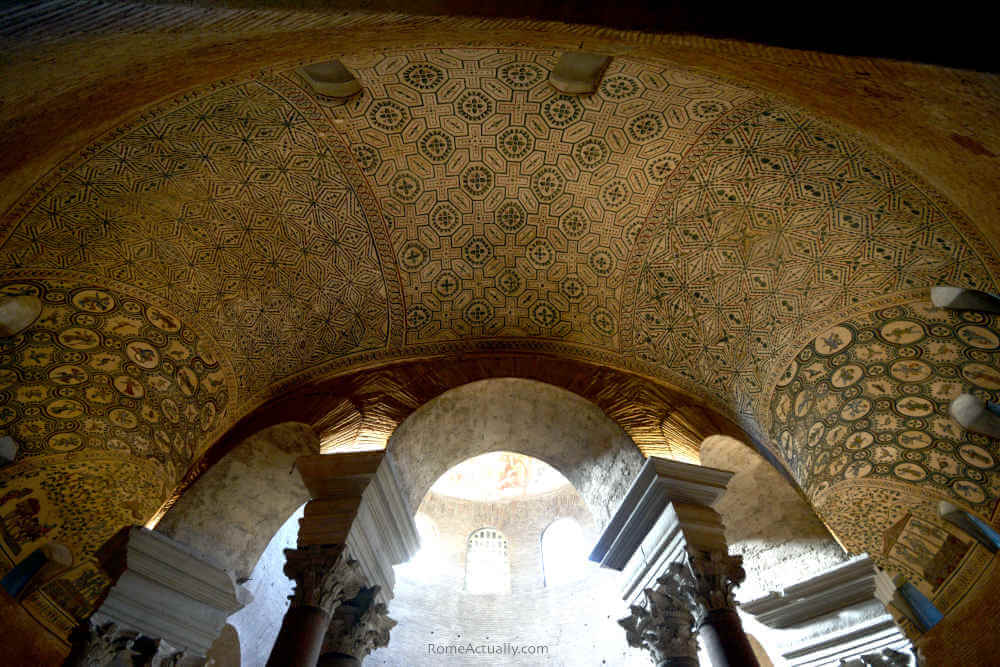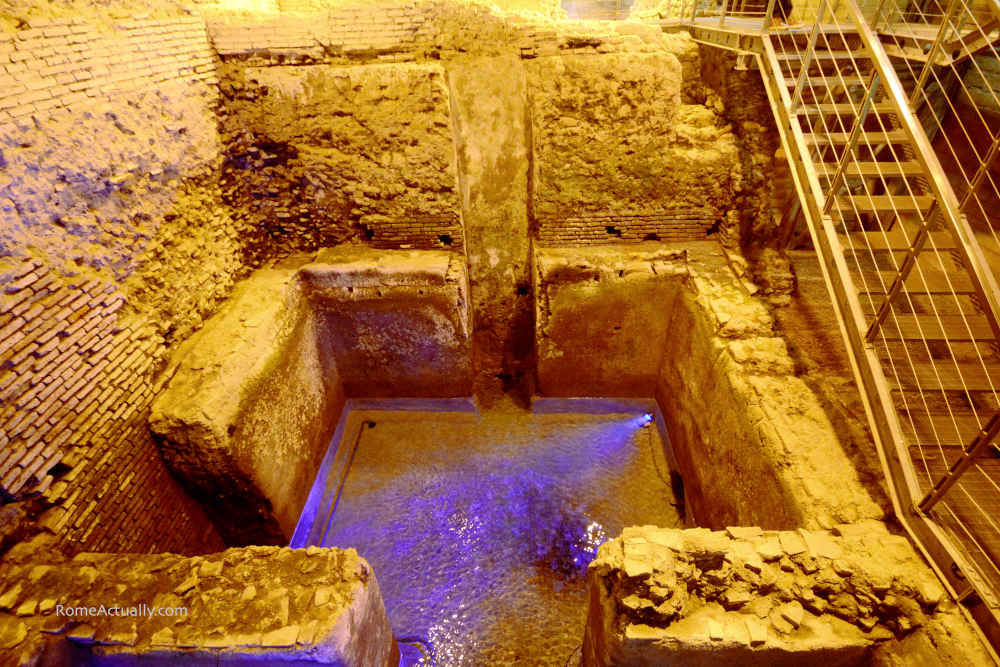So popular among tourists from all over the world that finding some hidden gems in Rome is becoming harder by the day. Hard but not impossible.
Of course, places that once were considered strongholds of “secret Rome” are now not so secret anymore. Guides from many travel outlets, mainstream and less mainstream, will very likely tell you to go and admire St. Peter’s cupola from the keyhole on the door of the Knights of Malta headquarters, or the nearby Garden of the Oranges, or even the Vatican Gardens. Maybe these were unique things to do in Rome a couple of years ago, but hardly now.
Lovers of offbeat travel, fret not, you landed in the very right spot to discover unusual places to visit in Rome. Get ready to enjoy the Eternal City just like a local.
Table of Contents
- 1 Map of the Rome’s best-kept secrets
- 2 Unusual and unique things to do in Rome
- 2.1 Quartiere Coppedè, an unusual side of Rome
- 2.2 Palazzo Barberini
- 2.3 The Appian Way to walk Rome off the beaten path
- 2.4 Villa Ada and its catacombs
- 2.5 Galleria Sciarra, Liberty-style gem
- 2.6 Street art in Rome’s Quadraro neighborhood
- 2.7 Basilica di Santa Cecilia in Trastevere
- 2.8 Villa Torlonia and Mussolini’s home, one of the unique places to visit in Rome
- 2.9 Porta Magica (Magic Door), a mysterious corner of Rome
- 2.10 The Protestant Cemetery, an under-the-radar gem in Rome Testaccio
- 2.11 Santa Prassede Basilica, one of the least visited churches in Rome
- 2.12 Sant’Agnese Fuori Le Mura in the Nomentano district
- 2.13 The Aventine Hill, a treasure trove of Rome’s hidden gems
- 2.14 Roseto Comunale, Rome’s Rose Garden
- 2.15 Santa Maria della Scala Pharmacy, a unique place in Rome’s Trastevere
- 2.16 See the Horti Sallustiani
- 2.17 Centrale Montemartini fascinating museum
- 2.18 Crypta Balbi
- 2.19 Passetto del Biscione secret passageway
- 2.20 Mausoleum of Augustus
- 2.21 Home of Mastro Titta, Rome’s executioner
- 2.22 Roman Domus of Palazzo Valentini
- 2.23 Roman Houses on Caelian Hill
- 2.24 Vicus Caprarius
- 2.25 Largo di Torre Argentina, a hidden gem in plain sight
- 2.26 Insula of Ara Coeli
Map of the Rome’s best-kept secrets
Unusual and unique things to do in Rome
Quartiere Coppedè, an unusual side of Rome
Among the most unusual places to visit in Rome, the first place goes to Quartiere Coppedé. Located in Rome’s Trieste neighborhood, this semi-hidden enclave designed by architect Gino Coppedè turns around Piazza Mincio and its quirky Fountain of the Frogs. Built between 1913 and 1926, you will see a series of buildings Liberty-style adorned with grotesque figures of monsters, animals and the elements of Greek, Baroque, Gothic and medieval arts.
After visiting and photographing this quaint and unusual corner of Rome, don’t rush back to the city center of the guidebooks. In this area, you can stop for lunch at exclusive eateries like one of my favorite vegetarian restaurants r the new Viking place Smor. You can also go shopping in one of the shops and department stores or visit the historical sites and museums in the area.
Make sure you read our article on the most beautiful and famous fountains in Rome.

Palazzo Barberini
Even though centrally located, Baroque-style Palazzo Barberini is quite an under-the-radar Rome attraction. Reachable with an easy 100-meter stroll from Barberini metro station, its entrance is in Via delle Quattro Fontane.
Designed by three of Italy’s greatest Baroque artists, Carlo Maderno, Gian Lorenzo Bernini and Francesco Borromini, inside you can visit masterpieces such as the wonderful fresco by Pietro da Cortona and famous paintings such as Raphael’s La Fornarina, Caravaggio‘s Judith Beheading Holofernes, and what, until not long ago, was believed to be Guido Reni’s portrait of Beatrice Cenci, the Roman patrician executed by beheading in the 16th century with the accusation of parricide.
Open to the public is also part of the private residence of the Barberini family that lived here until 1955.

READ MORE: Wondering where to eat in Rome? Check out our eBook Tasting Rome by Neighbourhood to discover the best restaurants for adventurous foodies in five district
The Appian Way to walk Rome off the beaten path
Known as Regina Viarum, the queen of all roads, the Appian Way goes all the way to the southern Italian Puglia region (Apulia). Even though crucial for the bygone life of imperial times, now it falls into the category of the unique things to do in Rome.
I can’t really say exactly what to visit along the Appian Way as it’s a huge road. Some of the highlights are the Catacombs of St. Callixtus, St. Sebastian and St. Domitilla, the Caffarella Park, the Tomb of Caecilia Metella and some well-preserved Roman aqueducts. Buses in this area are pretty seldom and timetables unreliable, so I definitely recommend a guided tour to explore the Appian Way.

Villa Ada and its catacombs
Formerly the residence of Italy’s royal family, the Savoys, Villa Ada is now one of Rome’s largest public parks. Here there are countless activities you can do. For a bit of exercising, you can walk, jog or rent a bike, but if you want to simply relax, you can set up a picnic and enjoy your lunch surrounded by green.
There is also a little dog space where owners bring their hairy friends to swim in the little lake devoted to them, play around, run and get tired.
Apart from being a great place to spend some time in nature, Villa Ada is also packed with historical sites. First and foremost, there are several catacombs, the cemeteries of early Christians, before Christianity was recognized as a religion and the persecution of its followers was forbidden.
Some of the best you can visit in Villa Ada are the Catacombs of Priscilla, with the entrance from the cloister of the Sisters of Priscilla in Via Salaria 430 (more info on the official website).
Galleria Sciarra, Liberty-style gem
Galleria Sciarra is a passageway roughly connecting Via del Corso with Fontana di Trevi. With the end of the Italian Risorgimento series of battles that resulted in the Italian unification and Rome due to become the young country’s capital, a frenzy of building and restoration began.
Noble and powerful families started to spruce up their palaces in an outburst of enthusiasm in wanting to give the city the look worthy of a capital. The paintings that make this covered passageway so beautiful and deserving of a stop are by Giuseppe Cellini and feature an all-around celebration of the woman as queen of the house, mother and worker.

Street art in Rome’s Quadraro neighborhood
Counting almost 3,000 years under its belt, sightseeing in Rome doesn’t only imply traveling back to BC times. Get off at Porta Furba/Quadraro station on metro line A and you will find yourself immersed in the burst of colors of the Quadraro street art.

Artists of the likes of Diavù (native of the area and founder of this street art project), Alice Pasquini, Beau Stanton, Dilkabear, Zelda Bomba and Gio Pistone have taken part in this project and managed to revamp this otherwise pretty uneventful neighborhood that never really attracted visitors.
Now, it not only attracts visitors but also photographers and guided tours. I have been there many times and always like to go back and take more pictures from previously neglected angles.
Basilica di Santa Cecilia in Trastevere
Often neglected and overshadowed by the most famous Santa Maria in Trastevere, Santa Cecilia in Trastevere Basilica is located in its semi-hidden namesake piazza and is one of the places to visit in Trastevere. Quite unassumingly from the outside, the interior is finely decorated and bears the final resting place of Santa Cecilia, the saint patron of music, whose body was transferred here from the previous tomb in the Catacombs of St. Callixtus.

After visiting the street-level basilica, don’t forget to go down one level and visit the luxurious crypt and then down again for an ancient Roman Domus and insula. Apart from being one of the least visited churches in Rome, it’s incredibly fascinating to see streets and buildings from imperial times.
Villa Torlonia and Mussolini’s home, one of the unique places to visit in Rome
More of a locals’ place rather than a tourist area, Villa Torlonia park, where was located the Roman residence of Fascist leader Benito Mussolini, Casino Nobile, that you can also visit.
Enjoy a stroll in this lovely park located some 2 km from Porta Pia, visit the Liberty-style Casina delle Civette, or House of the Owls, have a bite at La Limonaia bar/restaurant (Via Lazzaro Spallanzani 1A, inside Villa Torlonia, +39 06 95065250) and let your kids play at the local playground Technotown, a space devoted to the new technologies.
Recently open, another fantastic landmark to see in Villa Torlonia is the colorful Serra Moresca, a beautiful Moorish-style greenhouse, suggestive of the outlandish spirit of the former villa’s owners.

Porta Magica (Magic Door), a mysterious corner of Rome
Also called Porta Alchemica (Alchemical) or Porta dei Cieli (of the Skies), this is definitely one of the secret places in Rome. And one of the most mysterious, I would add.
Located in the gardens of Piazza Vittorio on Esquilino Hill, this strange structure was built between 1655 and 1680 by marquis Massimiliano Savelli Palombara inside his once residence, Villa Palombara, where today are the gardens. The nobleman got close to the world of alchemy and science as an aftermath of frequenting the palace of Queen Christina of Sweden who had a well-equipped lab managed by alchemist Pietro Antonio Bandiera.
According to the myth, the alchemist Francesco Giuseppe Borri stayed over Villa Palombara for one night in the quest for a magic herb able to produce gold. In the morning, he was seen stepping over the door and disappearing. In the process, he left behind some speck of gold result of an alchemic formula and a paper filled with symbols that revealed the secret of the philosopher’s stone. Those symbols are now the decoration of the Magic Door.
Since you are there, have a walk under the covered porticoes around Piazza Vittorio and visit the Nuovo Mercato Esquilino, a food market where you can find just about everything from all over the world.

READ MORE: Looking for a hotel in Rome? Here are our recommendations for budget and five-star accommodations in the city!
The Protestant Cemetery, an under-the-radar gem in Rome Testaccio
The Non-Catholic or Protestant Cemetery of Rome was created to be the final resting place of foreign diplomats, non-Catholics and foreigners living on Italian soil. Buried there are also the only son of German writer Goethe, Italian politician and founder of the Communist Party Antonio Gramsci, and English poet John Keats.
The tombs are beautiful sculptures and the cemetery lies on the backdrop of the Pyramid of Caius Cestius. You can spend a lovely afternoon admiring the sculptures and discovering how many notables are buried there. If you bump into some cats wandering around, it’s all normal, there is a large cat colony right there between the cemetery and the Pyramide.

Santa Prassede Basilica, one of the least visited churches in Rome
A truly fascinating hidden gem in Rome lies in the Esquilino neighborhood. Santa Prassede Basilica was named after Saint Prassede, sister of Saint Pudenziana, two noble Romans, daughters of a Senator, who converted to Christianity and were martyred.
In the same neighborhood, there is also the basilica devoted to St. Pudenziana, and both churches show wonderful religious mosaics.
Sant’Agnese Fuori Le Mura in the Nomentano district
This is one of the truly fascinating hidden gems in Rome. Little known probably because outside the Aurelian Walls that shape the city center and mark the main highlights, Sant’Agnese Fuori Le Mura is a vast complex including several highlights located in the large Via Nomentana.

Among these are a modern basilica, large early-Christian catacombs, the ruins of a 4th-century basilica built near the burial place of the young Sant’Agnese martyr, and the mausoleum of Costanza, daughter of Constantine the Great, much devout to the saint.
This Aventine Hill neighborhood, close to the heart of Ancient Rome, is a true treasure trove of hidden gems in Rome. Now very famous and almost always with a long queue, the Aventine Keyhole is actually its most touristy place alongside the panoramic Garden of the Oranges.

Enter the churches of this neighborhood and don’t limit yourself to the modern-day street level. Go underground and discover early-Christian basilicas, Roman houses, and Mithraic temples.
Once you reach Aventine Hill, some of the best landmarks to visit are Santa Sabina Basilica, the Church of Santa Prisca where is also a Mithra temple, and Sant’Alessio Basilica.
Roseto Comunale, Rome’s Rose Garden
Open every year at the beginning of the spring blossoming usually in April and May and the autumn blossoming in October, Rome’s rose garden is a wonderful place to visit for a relaxing stroll and beautiful views of the city.

On display here are more than one thousand among ancient and modern rose species coming from all over the world, including the green Chinensis Virdiflora, the stinky Rosa Foetida, and Rosa Chinensis Mutabilis that changes color every day.
Santa Maria della Scala Pharmacy, a unique place in Rome’s Trastevere
While Trastevere is definitely not off the beaten track, the ancient pharmacy of Santa Maria della Scala is one of the coolest hidden gems in Rome. Operative from the 16th century to 1954, here the Discalced Carmelite friars used to make potions, balms, oils, clay and herbal remedies for all kinds of ailments. It’s a small exhibition but very fascinating, one of the things I suggest you do in Rome.

See the Horti Sallustiani
The largest urban park of ancient Rome, Horti Sallustiani belonged to Julius Caesar. Rather than one of the hidden gems in Rome, it’s a lost one. Now, in fact, it’s private property so we can’t visit the whole park but we can see it from the entrance.
Unfortunately only a small piece, but if you visit the Centrale Montemartini Museum in the Ostiense neighborhood, you can see a large piece of the mosaics that formed the floor of the ancient villa at the Horti Sallustiani.
If you do visit, don’t miss a slice of goodness at Pinsere or grab a table in 50 Kalò, two of the best pizza places in Rome.
Centrale Montemartini fascinating museum
Centrale Montemartini is one of my favorite museums in Rome. I have visited many times and love to go back whenever I happen in the Ostiense neighborhood. At first, it might seem like a small museum but in reality, there is so much to see.

This has been Rome’s main power plant during the years of the city’s thriving industrial effort. Opened in 1912 between the General Warehouses and the left bank of the Tiber river, Centrale Montemartini was built in an area where it would have been easy to source the necessary water near the river. From here, electricity was produced with steam turbines, furnaces, and diesel engines.
Today, we can see the giant machines with classic Roman and Greek sculptures all around in a fascinating exhibition of the symbols of modern society sitting side by side with the vestiges of the ancient world.
Crypta Balbi
Crypta Balbi is located in Via delle Botteghe Oscure between Largo Argentina and Piazza Venezia. Adjacent to the theater Lucius Cornelius Balbo built in the 13th century BC, the crypt was a covered porch to serve as a protection for the citizens waiting to enter the theater in case of rain or as a refreshing point for the breaks during the plays.
One of the four venues of Museo Nazionale Romano, Crypta Balbi is currently closed to visitors because of a large project of renovating all the museum’s locations.
Passetto del Biscione secret passageway
The Passetto del Biscione is a secret passage that connects Via di Grottapinta with Piazza del Biscione. In Roman times, it used to connect the auditorium of the Teatro di Pompeo with its cavea. The Passetto covered corridor is called del Biscione due to the eel represented in the Orsini coat of arms, the family that owned the adjacent Palazzo Orsini Pio Righetti.

This hidden passageway, however, is also known as Arco di Grottapinta because of an ancient custom of naming “grotto” any dark ravine or nook and because of the frescoes cherubs, columns, and festoons decorating the ceiling and the walls of this truly hidden gem near Campo de’ Fiori in Rome.
Mausoleum of Augustus
The Mausoleum of Augustus was probably one of the most famous monuments of ancient times but now it’s hardly known and visited because it has been closed for some 14 years for renovation works. It has briefly reopened to visitors and now is closed again to allow more restoration work. Needless to say, in the short time it was open, I immediately visited.

This is the monumental funerary mausoleum that emperor Augustus built for himself and his family, the Gens Julia. Reaching some 45 meters (148 feet), the emperor ordered it to be built as tall as the nearby Pincio Mount so that it could be seen from every corner of the city. This would reiterate the divine nature of Augustus compared to the rest of the world, his relatives included.
The urn containing his ashes was placed in a higher position than those of the rest of his family and, on the top of the mausoleum was his shiny bronze statue. The idea for a glorious shrine started taking shape in Octavianus Augustus’ mind in 28 BC, two years after he had visited the mausoleum of Alexander the Great in Alexandria of Egypt.
This is a wonderful ancient site to visit in Rome. While at the moment it’s still closed, it will soon reopen. Check our guide to the Mausoleum of Augustus to know everything about the site and updates on when they open it again.
Make sure you read our article on the best archaeological sites in Rome.
Home of Mastro Titta, Rome’s executioner
A stone’s throw from St. Peter’s Basilica, tucked away in a dark alley known as Vicolo del Campanile, is the building that was the house of Giovan Battista Bugatti, better known as Mastro Titta, the historic executioner of papal Rome.

In the span of almost 70 years between 1796 and 1864, he executed 516 death penalties in places like Ponte Sant’Angelo bridge and Piazza del Popolo.
While it’s not possible to visit the house inside, you can duck into this narrow alley from Via della Conciliazione, right beside the church of Santa Maria in Traspontina, and see the wooden gate and the facade of the palace.
Roman Domus of Palazzo Valentini
Located near Piazza Venezia, Palazzo Valentini is a notable palace in Rome built in 1585 by the cardinal Michele Bonelli, nephew of pope Pious V. Since 1873, the palace has been the seat of Rome’s Province. Recent diggings have discovered a treasure of several patrician Roman houses, domus, belonging to wealthy families.
In your visit, you will be able to admire beautiful ancient mosaics, decorated walls, and polychrome floors, as well as the ruins of a monumental public building.
Roman Houses on Caelian Hill
Known as Case Romane del Celio, you can find these ancient Roman houses in the hidden passage known as Clivo di Scauro. This is a very important archaeological find because it’s a testimony of the passage from pagan to Christian times in Rome and also of the coexistence of the two religions for many years.

One of the highlights of this Roman houses also known as home of the martyrs John and Paul are the ancient frescoes beautifully preserved. When I visited the Roman Domus at Caelian Hill, there was the surprise of an aperitif prepared with typical dishes and recipes from ancient Rome.
Vicus Caprarius
This is an amazing archaeological site near the Trevi Fountain. Located in Vicolo del Puttarello backstreet, Vicus Caprarius opens up to a whole underground world. Descending the few stairs, in fact, you will access the cistern of the Aqua Virgo aqueduct that has supplied water to Fontana di Trevi for centuries as well as a neighborhood from Nero times urban planning.

Part of the district were also an ancient domus and rests of an insula, a type of block of flats popular in ancient Rome built for extensive residential use where workers usually lived, of which we can see some vestiges and trace their fate. After years of diggings, archaeologists found a brick stamp that led historians to place this insula in Nero’s time, making it the oldest found in Rome so far.
Largo di Torre Argentina encloses very important ruins from Ancient Rome. The area was a sacred site as it was home to four temples and it’s somehow a hidden gem because even though in the very middle of one of the business hubs of the city center, here people mainly stop to take the bus rather than take the time to admire the ruins. It’s fair to say that the site is still closed to visitors as diggings are going on, and it seems that the cats of the local feline colony are an attraction more than the ruins themselves.

One of the oldest temples in Largo Argentina was erected in the 3rd century BC. It has been identified as the Temple of Giuturna and was ordered by naval commander Gaius Lutatius Catulus after his victory in 241 BC the first Punic War. The construction of the other four temples followed and contributed to making this an important sacred area of Roman times.
Largo Argentina is also famous for being where the important Roman statesman and commander Julius Caesar was murdered.
Insula of Ara Coeli
These ancient Roman ruins are located in Piazza Venezia right at the foot of the staircase to reach the Ara Coeli Basilica on the slope of Capitoline Hill. While this is actually the opposite of what a hidden gem should be, their location leads most tourists to ignore them or just miss them. The site is closed to visitors but it’s visible from street level looking down.

The huge increase in the population in Rome between the end of republican times and the first two centuries of imperial Rome led to the development of a new type of residential buildings that would extend vertically instead of horizontally in order to solve the problem of overcrowding of the city.
Even though the area went through massive remodeling in the 1930s and much of the neighborhood was destroyed, the insula of the Ara Coeli survived the urban planning frenzy. We can still see all four floors, where were the shops (tabernae) located on the bottom floor.
WANT TO READ IT LATER? SAVE IT TO YOUR BOARD!






